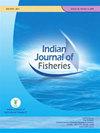Comparative study on growth performance and survival of Indian major carps and male monosex tilapia in recirculating aquaculture system
IF 0.3
4区 农林科学
Q4 FISHERIES
引用次数: 0
Abstract
An experiment was performed in a recirculatory aquaculture system (RAS) to carry out a comparative study on the growth performance and survival of Indian major carps (Labeo rohita and Gibelion catla) and monosex tilapia (Oreochromis niloticus) fingerlings for a period of 90 days. Ten fingerlings each of L. rohita (average weight 30±0.1 g), G. catla(average weight 28±0.1 g) and O. niloticus (average weight 31.5±0.2 g) were distributed randomly into twelve cages, in quadruplicates. L. rohita and G. catla were fed commercial floating feed (30% crude protein and 5% crude lipid) ad libitum while O. niloticus were initially fed at 3% of the body weight upto 100 g size and was changed to 2% of the body weight. There was significant (p<0.05) increase of daily weight gain, percentage weight gain and specific growth rate (SGR) in O. niloticus followed by L. rohita and G. catla. Significantly lower (p<0.05) feed conversion ratio (FCR) and higher (p<0.05) protein efficiency ratio (PER), protein productive value (PPV) and lipid productive value (LPV) were found in O. niloticus followed by L. rohita and G. catla. At the end of the experiment, survival was similar for all three fish species, however total biomass was significantly (p<0.05) higher in O. niloticus followed by L. rohita and G. catla. The findings of this study showed the potential of RAS as an alternative to the pond culture of monosex tilapia and rohu.Keywords: Growth performance, Indian major carps, Monosex tilapia, Survival, Recirculatory aquaculture system循环水养殖系统中印度鲤鱼与雄性单性罗非鱼生长性能及成活率的比较研究
本试验在循循环养殖系统(RAS)中对印度鲤鱼(Labeo rohita和Gibelion catla)和单性罗非鱼(Oreochromis niloticus)鱼苗的生长性能和成活率进行了为期90天的对比研究。选取平均体重30±0.1 g的罗氏乳鼠、平均体重28±0.1 g的卡特拉乳鼠和平均体重31.5±0.2 g的尼罗乳鼠各10只鱼种,随机分为12个笼,每笼4个重复。罗氏乳杆菌和鲇鱼随意饲喂商品浮动饲料(30%粗蛋白质和5%粗脂肪),尼罗氏乳杆菌最初饲喂体重的3%至100 g,后来改为体重的2%。日增重率、增重率和特定生长率均显著(p<0.05)高于黄颡鱼,黄颡鱼次之,黄颡鱼次之。结果表明,niloticus的饲料系数(FCR)显著低于(p<0.05),蛋白质效率(PER)、蛋白质生产价值(PPV)和脂肪生产价值(LPV)显著高于(p<0.05),其次是L. rohita和G. catla。试验结束时,三种鱼类的存活率相似,但总生物量以尼罗提鱼显著高于(p<0.05),其次是罗希塔鱼和卡特拉鱼。本研究结果表明,RAS有可能替代单性罗非鱼和罗虎的池塘养殖。关键词:生长性能,印度鲤鱼,单性罗非鱼,生存,循环式养殖系统
本文章由计算机程序翻译,如有差异,请以英文原文为准。
求助全文
约1分钟内获得全文
求助全文
来源期刊

Indian Journal of Fisheries
FISHERIES-
CiteScore
0.90
自引率
20.00%
发文量
0
审稿时长
6-12 weeks
期刊介绍:
Indian Journal of Fisheries is published quarterly by the Indian Council of Agricultural Research (ICAR), New Delhi. Original contributions in the field of Fish and fisheries science are considered for publication in the Journal. The material submitted must be unpublished and not under consideration for publication elsewhere.
Papers based on research which kills or damages any species, regarded as thratened/ endangered by IUCN crieteria or is as such listed in the Red Data Book appropriate to the geographic area concerned, will not be accepted by the Journal, unless the work has clear conservation objectives.
 求助内容:
求助内容: 应助结果提醒方式:
应助结果提醒方式:


